The title of Brendan Donnelly's first exhibition at Paul Loya Gallery, "How To Be A Magician In Your Spare Time," is something of a misnomer--the show has little to do with magic. However, the emptiness of the titular promise is itself an ironic trick in keeping with the artist's skepticism of magisterial charlatanry.
Lining the gallery walls are several car windshields overlaid with amusing assortments of decals, many of them designed by Donnelly himself. The carefully curated arrangement on each windshield portrays a different hypothetical character or group of characters that is humorously caricatural in its stereotypic extremism, yet not completely unbelievable. The decals on a screen ostensibly belonging to a right-wing radical, for example, reek of sexist vulgarity, white suprematism, and love of guns. A Rastafarian's stickers are all red, yellow, green, and black. Another windshield is peppered with stickers having to do with being Irish and drunk.
![2014-09-19-WindshieldInstallation.bmp]()
Installation view, "How To Be A Magician In Your Spare Time." Image courtesy of Paul Loya Gallery.
![2014-09-19-AngryDadSyndrome.bmp]()
Brendan Donnelly, "Angry Dad Syndrome." Found windshield and vinyl decals, 2014. Image courtesy of Paul Loya Gallery.
![2014-09-19-JahIsMyCoPilot.bmp]()
Brendan Donnelly, "Jah Is My Co-Pilot." Found windshield and vinyl decals, 2014. Image courtesy of Paul Loya Gallery.
Initially, each windshield seems to stand out in clamorous divergence from all the others. However, the comparatively superficial differences in lifestyle, creed, and ethnicity belie a more significant common denominator among these hypothetical characters. The cocksure blatancy in each assortment evinces a mixture of self-pride, strong convictions, and often, scorn. Donnelly's installation is a reminder that no one is immune to judgment; and the more one celebrates one's own predilections and prejudices, the more one is subject to the bias of others.
The fundamental similarity among these stereotyped characters is echoed in their appropriation of one another's symbols. Clichéd motifs from some groups are appropriated and recycled by others, whether in ironic opposition with the motif's original meaning or in modified accordance with it. For instance, the Confederate flag design is reinvented in rainbow colors as the "Rainbow Rebel" flag to represent gay pride. On other windshields, the same design is seen in Rastafarian colors or Irish colors. Recycling a popular symbol heightens the arbitrary relationship between the symbol and its meaning; but it also blurs the boundaries dividing each faction using the symbol. The only features distinguishing a Confederate flag from a "Rainbow Rebel" are color and a few background stripes. Each reuse pushes the symbol closer to becoming an empty shell to fill with the meaning of one's choice, eventually sending the original symbol and its reinvented successors into a hackneyed state of oblivion.
Beyond the windshields, in the back of the gallery stands an imposingly tall chain-link National Rent-a-Fence in three parts, each parallel to one of the gallery walls. Attached to the fence are several black and white paintings, dark and poster-like on unstretched canvas, bearing cryptic slogan-like text coupled with equally mysterious pictures. The style of these paintings is borrowed from Chick Publications, a popular brand of evangelical Bible tracts; but the parody isn't directed so much at religion as at the dogmatism often associated with it.
![2014-09-19-FenceInstallation.bmp]()
Installation view, "How To Be A Magician In Your Spare Time." Image courtesy of Paul Loya Gallery.
"The Greatest Story Ever Told," whose text is directly copied from a Chick leaflet of the same name, depicts Walt Disney's severed head smoking a cigarette as it falls into a chasm underneath Sleeping Beauty Castle, which is haloed by a ring of hypnotic concentric circles extending into the sky. The simplicity of the drawing calls attention to the relationship between crosses and Mickey Mouse logos on the castle turrets, simultaneously burlesquing both Disney worship and religious groups' boycotts of the brand.
![2014-09-19-TheGreatestStoryEverTold.bmp]()
Brendan Donnelly, "The Greatest Story Ever Told." Acrylic on canvas, 2014. Image courtesy of Paul Loya Gallery.
"Life sucks, then you die," reads the text next to an image of a big skeleton resting its elbow on a child skeleton's skull. "Then you're reincarnated and life sucks again." Generally, religion is supposed to provide hope and comfort to its believers; the idea of life after death is usually considered positive. Donnelly satirically points out that should one not enjoy life, the idea of eventual death could actually be comforting; the idea of reincarnation, an exhausting vicious circle.
![2014-09-19-LifeSucksThenYouDie.bmp]()
Brendan Donnelly, "Life Sucks, Then You Die." Acrylic on canvas, 2014. Image courtesy of Paul Loya Gallery.
Whereas his windshield pieces represent misguided senses of anti-establishment individualism on the part of people who are actually members of classifiable cliques, Donnelly's fence installation is redolent of the shortcomings of cultish doctrinaire propaganda and the resulting delusional melancholia of its jaded proponents and followers. As a whole, the show unmasks contradictions and duplicity inherent to any kind of extremism or unquestioning adherence to dogma. Yet at the same time, it alludes to the fact that we are all opinionated to some degree. Through his work, Donnelly cautions against feeling too certain.
"How To Be A Magician In Your Spare Time" is on view from September 6-October 25, 2014 at Paul Loya Gallery, 2677 S. La Cienega Blvd, Los Angeles, CA 90034. For further information, see paulloyagallery.com
Lining the gallery walls are several car windshields overlaid with amusing assortments of decals, many of them designed by Donnelly himself. The carefully curated arrangement on each windshield portrays a different hypothetical character or group of characters that is humorously caricatural in its stereotypic extremism, yet not completely unbelievable. The decals on a screen ostensibly belonging to a right-wing radical, for example, reek of sexist vulgarity, white suprematism, and love of guns. A Rastafarian's stickers are all red, yellow, green, and black. Another windshield is peppered with stickers having to do with being Irish and drunk.

Installation view, "How To Be A Magician In Your Spare Time." Image courtesy of Paul Loya Gallery.
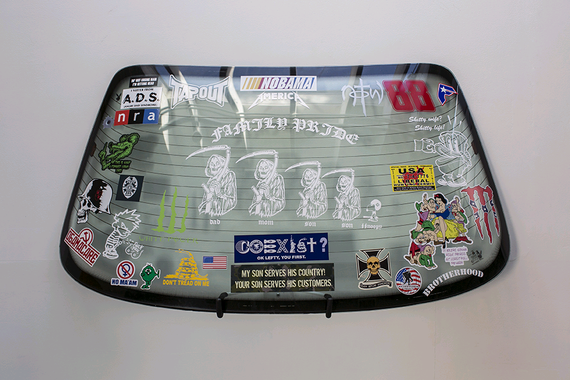
Brendan Donnelly, "Angry Dad Syndrome." Found windshield and vinyl decals, 2014. Image courtesy of Paul Loya Gallery.
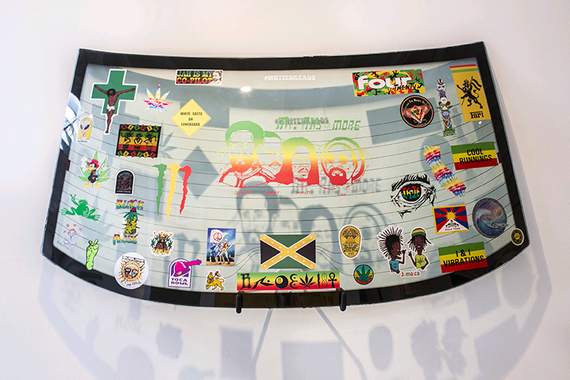
Brendan Donnelly, "Jah Is My Co-Pilot." Found windshield and vinyl decals, 2014. Image courtesy of Paul Loya Gallery.
Initially, each windshield seems to stand out in clamorous divergence from all the others. However, the comparatively superficial differences in lifestyle, creed, and ethnicity belie a more significant common denominator among these hypothetical characters. The cocksure blatancy in each assortment evinces a mixture of self-pride, strong convictions, and often, scorn. Donnelly's installation is a reminder that no one is immune to judgment; and the more one celebrates one's own predilections and prejudices, the more one is subject to the bias of others.
The fundamental similarity among these stereotyped characters is echoed in their appropriation of one another's symbols. Clichéd motifs from some groups are appropriated and recycled by others, whether in ironic opposition with the motif's original meaning or in modified accordance with it. For instance, the Confederate flag design is reinvented in rainbow colors as the "Rainbow Rebel" flag to represent gay pride. On other windshields, the same design is seen in Rastafarian colors or Irish colors. Recycling a popular symbol heightens the arbitrary relationship between the symbol and its meaning; but it also blurs the boundaries dividing each faction using the symbol. The only features distinguishing a Confederate flag from a "Rainbow Rebel" are color and a few background stripes. Each reuse pushes the symbol closer to becoming an empty shell to fill with the meaning of one's choice, eventually sending the original symbol and its reinvented successors into a hackneyed state of oblivion.
Beyond the windshields, in the back of the gallery stands an imposingly tall chain-link National Rent-a-Fence in three parts, each parallel to one of the gallery walls. Attached to the fence are several black and white paintings, dark and poster-like on unstretched canvas, bearing cryptic slogan-like text coupled with equally mysterious pictures. The style of these paintings is borrowed from Chick Publications, a popular brand of evangelical Bible tracts; but the parody isn't directed so much at religion as at the dogmatism often associated with it.
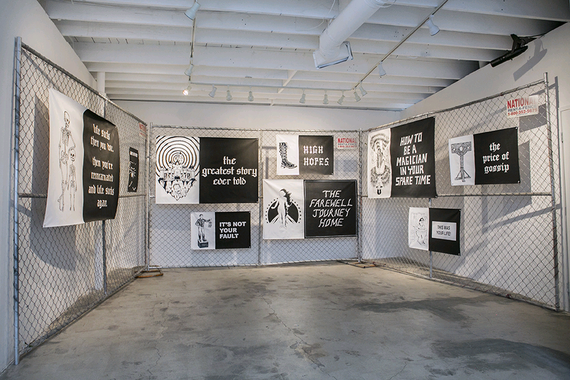
Installation view, "How To Be A Magician In Your Spare Time." Image courtesy of Paul Loya Gallery.
"The Greatest Story Ever Told," whose text is directly copied from a Chick leaflet of the same name, depicts Walt Disney's severed head smoking a cigarette as it falls into a chasm underneath Sleeping Beauty Castle, which is haloed by a ring of hypnotic concentric circles extending into the sky. The simplicity of the drawing calls attention to the relationship between crosses and Mickey Mouse logos on the castle turrets, simultaneously burlesquing both Disney worship and religious groups' boycotts of the brand.
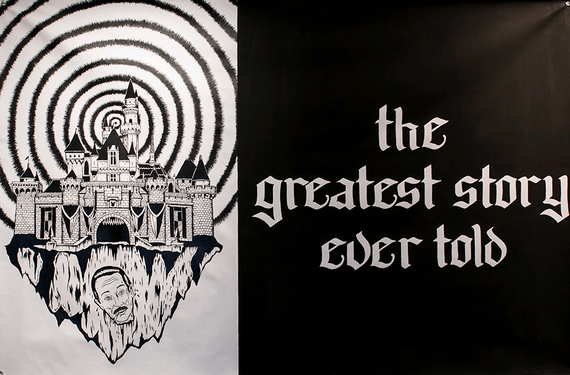
Brendan Donnelly, "The Greatest Story Ever Told." Acrylic on canvas, 2014. Image courtesy of Paul Loya Gallery.
"Life sucks, then you die," reads the text next to an image of a big skeleton resting its elbow on a child skeleton's skull. "Then you're reincarnated and life sucks again." Generally, religion is supposed to provide hope and comfort to its believers; the idea of life after death is usually considered positive. Donnelly satirically points out that should one not enjoy life, the idea of eventual death could actually be comforting; the idea of reincarnation, an exhausting vicious circle.
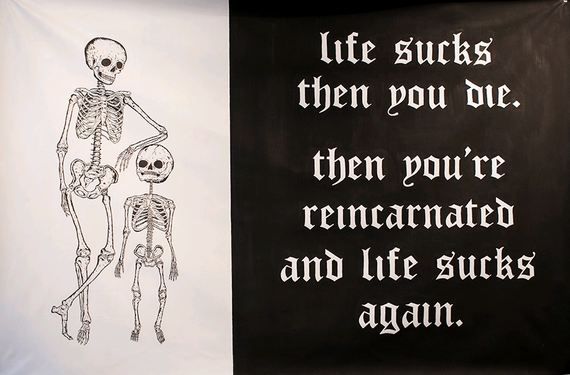
Brendan Donnelly, "Life Sucks, Then You Die." Acrylic on canvas, 2014. Image courtesy of Paul Loya Gallery.
Whereas his windshield pieces represent misguided senses of anti-establishment individualism on the part of people who are actually members of classifiable cliques, Donnelly's fence installation is redolent of the shortcomings of cultish doctrinaire propaganda and the resulting delusional melancholia of its jaded proponents and followers. As a whole, the show unmasks contradictions and duplicity inherent to any kind of extremism or unquestioning adherence to dogma. Yet at the same time, it alludes to the fact that we are all opinionated to some degree. Through his work, Donnelly cautions against feeling too certain.
"How To Be A Magician In Your Spare Time" is on view from September 6-October 25, 2014 at Paul Loya Gallery, 2677 S. La Cienega Blvd, Los Angeles, CA 90034. For further information, see paulloyagallery.com